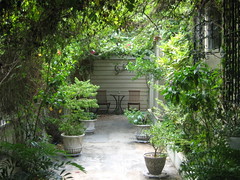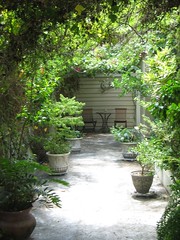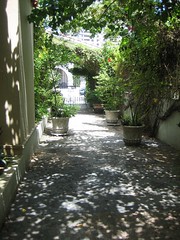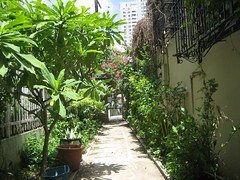The article below, discovered in a 2010 National Geographic, has been a pleasure. One of those bedtime or mornings with Coffea arabica readings, stimulating with energy and purpose.
WITHIN ONE CUBIC FOOT
Miniature Surveys of Biodiversity
by
Edward O. Wilson
Within One Cubic Foot
Guess how many organisms you'll find in a cube of soil or sea.
Photograph by David Liittschwager
When you thrust a shovel into the soil or tear off a piece of
coral, you are, godlike, cutting through an entire world. You have
crossed a hidden frontier known to very few. Immediately close at hand,
around and beneath our feet, lies the least explored part of the
planet's surface. It is also the most vital place on Earth for human
existence.
In any habitat, on the ground, in the forest canopy, or in the water, your eye is first caught by the big animals—birds, mammals, fish, butterflies. But gradually the smaller inhabitants, far more numerous, begin to eclipse them. There are the insect myriads creeping and buzzing among the weeds, the worms and unnameable creatures that squirm or scuttle for cover when you turn garden soil for planting. There are those annoying ants that swarm out when their nest is accidentally cut open and the pesky beetle grubs exposed at yellowed grass roots. When you flip a rock over, there are even more: You see spiderlings and sundry pale unknowns of diverse form slinking through mats of fungus strands. Tiny beetles hide from the sudden light, and pill bugs curl their bodies into defensive balls. Centipedes and millipedes, the armored snakes of their size class, squeeze into the nearest crevices and wormholes.
In any habitat, on the ground, in the forest canopy, or in the water, your eye is first caught by the big animals—birds, mammals, fish, butterflies. But gradually the smaller inhabitants, far more numerous, begin to eclipse them. There are the insect myriads creeping and buzzing among the weeds, the worms and unnameable creatures that squirm or scuttle for cover when you turn garden soil for planting. There are those annoying ants that swarm out when their nest is accidentally cut open and the pesky beetle grubs exposed at yellowed grass roots. When you flip a rock over, there are even more: You see spiderlings and sundry pale unknowns of diverse form slinking through mats of fungus strands. Tiny beetles hide from the sudden light, and pill bugs curl their bodies into defensive balls. Centipedes and millipedes, the armored snakes of their size class, squeeze into the nearest crevices and wormholes.
It may seem that the whole icky lot of them, and the miniature
realms they inhabit, are unrelated to human concerns. But scientists
have found the exact opposite to be true. Together with the bacteria and
other invisible microorganisms swimming and settled around the mineral
grains of the soil, the ground dwellers are the heart of life on Earth.
The terrain they inhabit is not just a matrix of dirt and rubble. The entire ground habitat is alive. Living forms create virtually all of the substances that flow around the inert grains.
If all the organisms were to disappear from any one of the cubic spaces depicted in these photographs, the environment in it would soon shift to a radical new state. The molecules of the soil or streambed would become smaller and simpler. The ratios of oxygen, carbon dioxide, and other gases in the air would change. Altogether, a new physical equilibrium would be approached, at which the cubic foot would resemble that on some distant, sterile planet.
Earth is the only planet we know that has a biosphere. This thin, membranous layer of life is our only home. It alone is able to maintain the exact environment we ourselves need to stay alive.
Most of the organisms of the biosphere, and the vast number of its species, can be found at the surface or just below it. Through their bodies pass the cycles of chemical reactions upon which all of life depends. With precision exceeding anything our technology can match, some of the species break down the dead plant and animal material falling from above. Specialized predators and parasites feed on these scavengers, and higher level specialists feed on them in turn. The whole, working together in a constant turnover of birth and death, returns to the plants the nutrients needed to continue photosynthesis. Without the smooth working of all this linkage, the biosphere would cease to exist.
Thus, we need all of this biomass and biodiversity, including all of the creepy-crawlies. Yet in spite of its vital role, life at the ground level remains relatively unknown, even to scientists. About 60,000 species of fungi have been discovered and studied, for example, including mushrooms, rusts, and molds, but specialists estimate that more than 1.5 million species actually exist on Earth. Along with them in the soil thrive some of the most abundant animals in the world, the nematodes, also known as roundworms. These include, among other forms, the barely visible white wigglers that can be found everywhere just underground. Tens of thousands of roundworm species are known, and the true number could be in the millions. Both fungi and roundworms are outdone dramatically in turn by still smaller organisms. In a pinch of garden soil, about a gram in weight, live millions of bacteria, representing several thousand species. Most of them are unknown to science.
The terrain they inhabit is not just a matrix of dirt and rubble. The entire ground habitat is alive. Living forms create virtually all of the substances that flow around the inert grains.
If all the organisms were to disappear from any one of the cubic spaces depicted in these photographs, the environment in it would soon shift to a radical new state. The molecules of the soil or streambed would become smaller and simpler. The ratios of oxygen, carbon dioxide, and other gases in the air would change. Altogether, a new physical equilibrium would be approached, at which the cubic foot would resemble that on some distant, sterile planet.
Earth is the only planet we know that has a biosphere. This thin, membranous layer of life is our only home. It alone is able to maintain the exact environment we ourselves need to stay alive.
Most of the organisms of the biosphere, and the vast number of its species, can be found at the surface or just below it. Through their bodies pass the cycles of chemical reactions upon which all of life depends. With precision exceeding anything our technology can match, some of the species break down the dead plant and animal material falling from above. Specialized predators and parasites feed on these scavengers, and higher level specialists feed on them in turn. The whole, working together in a constant turnover of birth and death, returns to the plants the nutrients needed to continue photosynthesis. Without the smooth working of all this linkage, the biosphere would cease to exist.
Thus, we need all of this biomass and biodiversity, including all of the creepy-crawlies. Yet in spite of its vital role, life at the ground level remains relatively unknown, even to scientists. About 60,000 species of fungi have been discovered and studied, for example, including mushrooms, rusts, and molds, but specialists estimate that more than 1.5 million species actually exist on Earth. Along with them in the soil thrive some of the most abundant animals in the world, the nematodes, also known as roundworms. These include, among other forms, the barely visible white wigglers that can be found everywhere just underground. Tens of thousands of roundworm species are known, and the true number could be in the millions. Both fungi and roundworms are outdone dramatically in turn by still smaller organisms. In a pinch of garden soil, about a gram in weight, live millions of bacteria, representing several thousand species. Most of them are unknown to science.
Ants, with more than 12,000 described species in the world (and
the group on which I specialize as a naturalist), are among the better
studied insects. Yet it's a good guess that the actual number is double
or even triple that. In 2003 I completed a study of the "big-headed
ants" of the Western Hemisphere, a genus (Pheidole) that has the
largest number of known species and is among the most abundant of all
the ants. At the end of my study, after 18 years of off-and-on effort, I
had distinguished 624 species. A majority, 337, were new to science.
Only a dozen or so of the species have been closely studied. One of the smallest, I discovered, feeds on oribatid mites, which are usually much smaller than the letter o on this page and resemble a cross between a spider and a turtle. Oribatids are among the most abundant creatures of their size in the soil. A cubic foot might contain thousands of individuals. Yet I found that their diversity and habits remain largely unknown, much more than in the case of ants.
Life at the ground level is not just a random mix of species, not an interspersion of fungi, bacteria, worms, ants, and all the rest. The species of each group are strictly stratified by depth. In passing from just above the surface on down, the conditions of the microenvironment change gradually but dramatically. Inch by inch there are shifts in light and temperature, the size of the cavities, the chemistry of the air, soil, or water, the kind of food available, and the species of organisms. The combination of these properties, down to a microscopic level, defines the surface ecosystem. Each species is specialized to survive and reproduce best in its particular niche.
Soil studies, and especially the biology of the ground level, is growing rapidly into a major branch of science. Now bacteria and other microscopic forms of life can be identified quickly by the decoding of their DNA. The life cycles of increasing numbers of insects and other invertebrate animals, many entirely unknown to science, are being explored in the field and laboratory. Their physical and nutritional needs are coming clear, species by species. The Encyclopedia of Life, available in a single address (eol.org), is gathering all known information on each species and making it available free throughout the world.
A small world awaits exploration. As the floras and faunas of the surface are examined more closely, the interlocking mechanisms of life are emerging in ever greater and more surprising detail. In time we will come fully to appreciate the magnificent little ecosystems that have fallen under our stewardship.
AS time goes by, getting older, still impatient, one thing is more cliched transparent, crystal clear, if our surroundings are not studied, understood, the imbecilic planting of trees in urban/rural contexts, taking place in Puerto Rico becomes
more and more inane, useless.
Only a dozen or so of the species have been closely studied. One of the smallest, I discovered, feeds on oribatid mites, which are usually much smaller than the letter o on this page and resemble a cross between a spider and a turtle. Oribatids are among the most abundant creatures of their size in the soil. A cubic foot might contain thousands of individuals. Yet I found that their diversity and habits remain largely unknown, much more than in the case of ants.
Life at the ground level is not just a random mix of species, not an interspersion of fungi, bacteria, worms, ants, and all the rest. The species of each group are strictly stratified by depth. In passing from just above the surface on down, the conditions of the microenvironment change gradually but dramatically. Inch by inch there are shifts in light and temperature, the size of the cavities, the chemistry of the air, soil, or water, the kind of food available, and the species of organisms. The combination of these properties, down to a microscopic level, defines the surface ecosystem. Each species is specialized to survive and reproduce best in its particular niche.
Soil studies, and especially the biology of the ground level, is growing rapidly into a major branch of science. Now bacteria and other microscopic forms of life can be identified quickly by the decoding of their DNA. The life cycles of increasing numbers of insects and other invertebrate animals, many entirely unknown to science, are being explored in the field and laboratory. Their physical and nutritional needs are coming clear, species by species. The Encyclopedia of Life, available in a single address (eol.org), is gathering all known information on each species and making it available free throughout the world.
A small world awaits exploration. As the floras and faunas of the surface are examined more closely, the interlocking mechanisms of life are emerging in ever greater and more surprising detail. In time we will come fully to appreciate the magnificent little ecosystems that have fallen under our stewardship.
AS time goes by, getting older, still impatient, one thing is more cliched transparent, crystal clear, if our surroundings are not studied, understood, the imbecilic planting of trees in urban/rural contexts, taking place in Puerto Rico becomes
more and more inane, useless.






